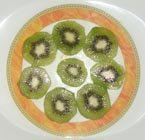Health Benefits of Kiwifruit: A Nutritious and Delicious Addition to Your Diet
Kiwifruit, also known as Chinese gooseberry, is a delicious tropical fruit packed with essential nutrients and health benefits. From boosting immunity to promoting digestion, kiwifruit is a versatile fruit that can be enjoyed in various ways.
Selection and Storage Guidelines
The kiwifruit season typically runs from September to November, with peak quality observed between August and December. It’s advisable to harvest only mature fruits and handle them with care when plucking them from the vine.
When unripe, kiwifruits are hard, starchy, and inedible, bearing a close resemblance to sapodilla (sapote) fruit.
To ripen raw kiwifruits, place them in a plastic bag for 4-6 days. Accelerate the ripening process by storing them in a paper bag alongside an apple, banana, or pears.
When selecting kiwifruits at the store, opt for specimens with intact skin, devoid of any surface blemishes or cuts. Ripe kiwis will yield to gentle pressure when pressed with the thumb. Once ripe, they have a short shelf life and are prone to damage if left exposed at room temperature. To prolong shelf life, store them in the refrigerator at the appropriate humidity level.
Preparation and Serving Techniques
Fresh, delectable, and juicy kiwifruit can be enjoyed as is. Simply wash it under cold running water. Its peel is not only edible but also nutritious. After cutting, consume the slices promptly, as they tend to become soggy when exposed to air for too long.
Here are some serving tips:
- Kiwifruits are so delightful on their own that they require no additional seasoning or accompaniments. Savor their rich, distinctive flavor.
- Pair sliced kiwifruit with strawberries and yogurt, as their flavors naturally complement each other.
- Create a sauce by combining sliced kiwifruit and pineapple, ideal for marinating chicken breast and boiling. The active compound, actinidin, found in kiwifruit, aids in tenderizing meat.
- Explore the fruit’s use in crafting New Zealand’s beloved dessert, Pavlova.
- Incorporate kiwifruit into recipes such as muffins, cheesecakes, party cakes, pies, juice, and jellies.
- Enjoy dried kiwi slices as a snack or add them to fruit salads and ice creams for an extra burst of flavor.
Safety Profile
Allergic reactions to kiwi fruit are uncommon. Both pregnant mothers and children can safely consume them.
While consuming kiwi skin typically doesn’t lead to adverse effects, many individuals prefer to discard it due to personal preference. Baby kiwis, however, can be enjoyed with their skin, similar to grapes and kumquats.
FAQs
Are kiwifruits good for weight loss?
Kiwifruits are low in calories and high in fiber, making them a great addition to a weight loss diet. They can help you feel full and satisfied while providing essential nutrients.
Can I freeze kiwifruit for later use?
Yes, you can freeze peeled and sliced kiwifruit for later use. They can be added to smoothies or used as a topping for yogurt and oatmeal.
How can I tell if a kiwifruit is ripe?
A ripe kiwifruit will yield to gentle pressure when pressed with the thumb. The skin should be free of any cuts or bruises.
Conclusion
Kiwifruit is not only delicious but also a powerhouse of essential nutrients. Include this vibrant fruit in your diet to reap its numerous health benefits and enjoy its unique flavor. Whether eaten on its own or incorporated into various recipes, kiwifruit is a versatile and nutritious addition to any meal plan.
For more information on kiwifruit nutrition and other fruits, visit our page.
Explore the world of fruits and their health benefits on our .
